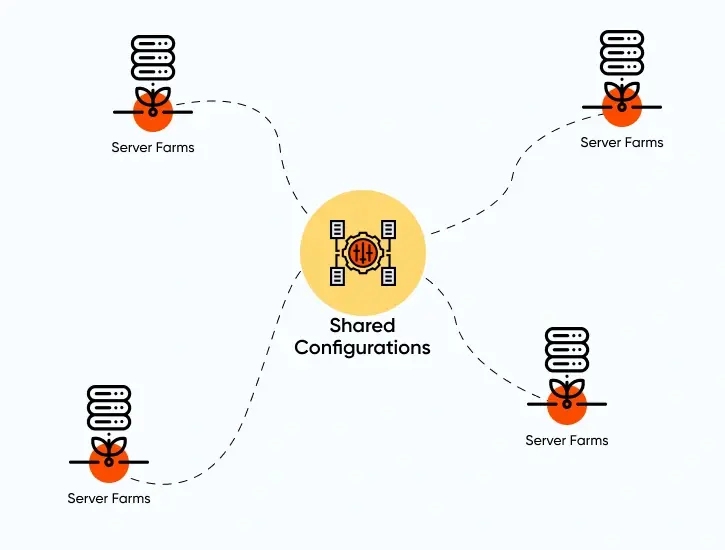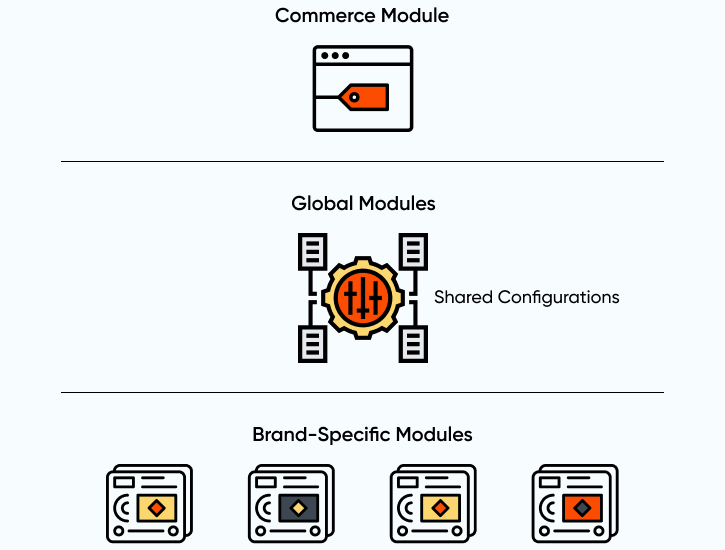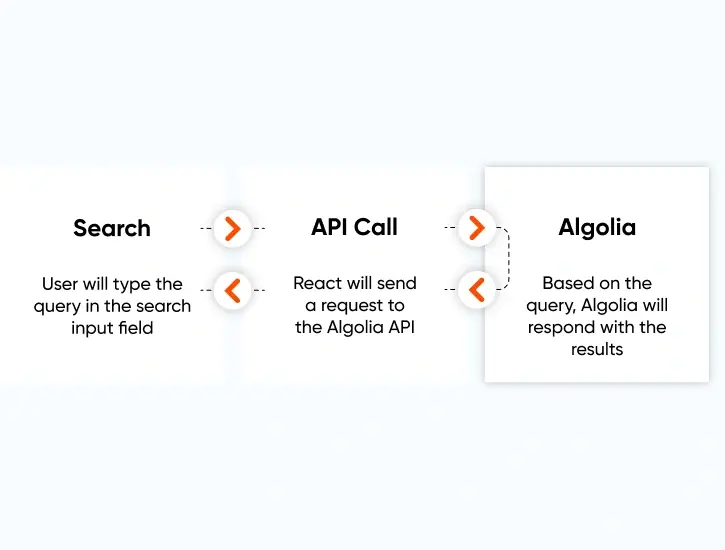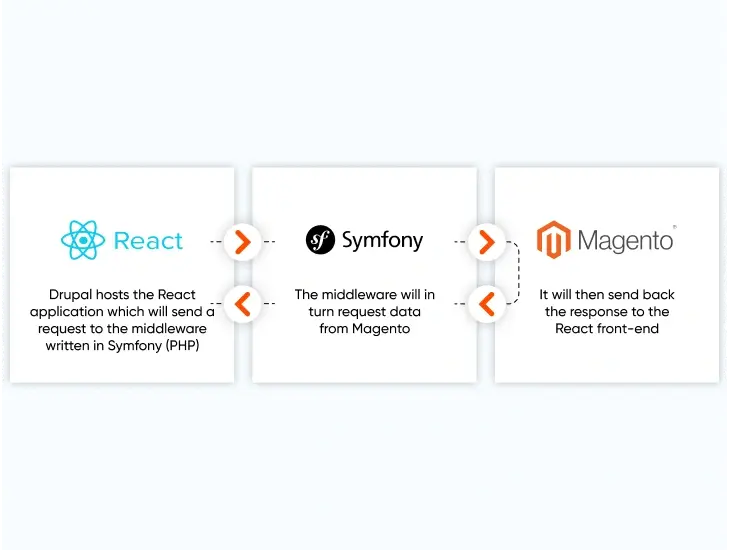Enhancing Multisite Retail Experiences
The customer, a leading global retail franchise with over 90 renowned brands and 4000+ stores worldwide, faced significant challenges due to a fragmented digital presence across various CMS platforms.
To address these issues, Axelerant, in partnership with Acquia, implemented a unified multisite solution using Drupal and Magento. This approach streamlined content management and ecommerce capabilities, reduced maintenance costs, and improved the overall user experience.
About the Customer
The customer is a prominent international retail franchise with a diverse portfolio of over 90 renowned consumer brands. With more than 4000 stores operating across major global markets, the franchise has a 30+ year history of industry leadership.
Despite their extensive physical presence, many of their brands lacked a unified online presence or ecommerce capabilities, particularly in the Middle East.
- 4000+
Stores
- 90+
Consumer Retail Brands
- 30+
Years Of Service

The Challenge
The retail franchise faced a range of complex challenges that impeded their ability to manage and scale their digital presence effectively:
1. Fragmented Digital Ecosystem
- Multiple CMS Platforms: With nearly 90 brands using various CMS platforms—including Drupal, Magento, and other open source and proprietary systems—there was a lack of consistency and integration across the brand websites.
- Disparate Systems: The inconsistency in platforms led to significant difficulties in maintaining and updating websites, as each system required different processes and tools.
2. Lack Of Web Presence
- Physical Stores Only: In many Middle Eastern markets, several brands had only physical stores with no online presence, limiting their ability to reach customers.
- Inconsistent Ecommerce Capabilities: Among those with an online presence, many lacked integrated ecommerce functionalities, such as shopping carts and checkout processes, resulting in missed revenue opportunities.
3. High Operational Costs
- Maintenance And Updates: Managing multiple platforms led to high maintenance costs, with frequent updates, security patches, and troubleshooting consuming valuable resources.
- Resource Allocation: Significant resources were required to support the varied platforms, resulting in inefficient use of the franchise’s technical and editorial teams.
4. Inconsistent User Experience
- Varied Customer Experiences: The lack of standardization resulted in an inconsistent user experience across different brand websites, affecting customer satisfaction and brand perception.
- Editorial Disparities: Editorial teams faced challenges in managing content across diverse systems, impacting their ability to deliver a cohesive brand message and timely updates.
5. Delayed Brand Launches
- Slow Time-to-Market: The inefficiencies of the existing systems led to delays in launching new brand websites, impacting the franchise’s ability to quickly enter new markets and respond to business opportunities.
- Complex Deployment Process: The process of setting up new websites was cumbersome and slow, requiring extensive development and configuration efforts for each new brand.
6. Scalability Constraints
- Difficulty In Scaling: The existing infrastructure struggled to scale effectively, making it difficult to manage a growing number of brands and their associated digital needs.
- Performance Issues: Performance issues arose from the disparate systems, affecting the speed and reliability of websites, particularly during high-traffic periods.
7. Regional Adaptations
- Multilingual And RTL Support: The need for multilingual capabilities and right-to-left (RTL) language support added complexity to the site configurations, particularly for markets in the Middle East.
- Localization Challenges: Adapting sites for local markets, including currency, language, and cultural preferences, required extensive customization and coordination.
8. Maintenance During Peak Loads
- Handling High Traffic: Managing website performance during peak shopping periods like Black Friday and Cyber Monday required careful planning and robust support mechanisms to ensure stability and reliability.
- Hypercare Requirements: A dedicated 24x7 support team was needed to handle peak loads and address any issues promptly, adding to the operational burden.
These challenges highlighted the need for a comprehensive and unified digital solution to streamline operations, enhance the customer experience, and reduce overall costs.

The Solution
To address the challenges faced by the client, Axelerant and Acquia developed a comprehensive solution that unified the digital experience across all brands, streamlined operations, and enhanced both content and ecommerce capabilities.
1. Unified Digital Platforms
- Drupal And Magento: To consolidate the digital presence, Drupal 8 was selected as the CMS due to its superior content management and editorial capabilities, while Magento was used for robust ecommerce functionalities. The integration of these platforms provided a seamless experience for both content and commerce.
- Acquia Cloud Site Factory: Leveraging Acquia Cloud Site Factory allowed for the efficient provisioning and management of multiple sites from a centralized platform. This tool simplified the deployment of new sites and ensured consistent management across the franchise’s vast portfolio.
2. Streamlined Content Management
- Custom Drupal-Magento Connector: A custom connector module was developed to integrate Drupal’s content management with Magento’s ecommerce features. This allowed for a unified interface where users could manage both content and product transactions seamlessly.
- Enhanced Editorial Experience: Drupal’s editorial tools, including content scheduling, workflow automation, and user-friendly interfaces, enabled faster and more accurate content management.
3. Efficient Site Provisioning And Maintenance
- Quicker Time To Market: The Acquia Cloud Site Factory tool was utilized to quickly launch new brand websites using pre-configured templates. This tool enabled rapid site deployment with minimal development effort, significantly reducing time-to-market for new brands.
- Whitelabel Themes: A flexible, whitelabel theme was designed to accommodate the branding needs of different franchises. The theme allowed for easy customization of colors, fonts, and design styles while maintaining a consistent layout across all sites.
4. Integration of Ecommerce Capabilities
- Magento Integration: Magento was integrated to handle cart management, discounts, and product stock & inventory. This ensured a robust ecommerce experience with features such as single-page checkout and custom loyalty card integration.
- React-Based Checkout: The checkout process was optimized with a React-based single-page checkout, improving performance and reducing the number of API calls required during the checkout process.
5. Multilingual And RTL Support
- Drupal Core Translation Features: The solution included comprehensive multilingual support, with Drupal’s core translation features enabling accurate translation and RTL compatibility for Arabic language sites.
- Localized Customizations: Brand sites were customized to meet regional requirements, including currency formatting, language preferences, and cultural considerations.
6. Peak Load Management
- Hypercare Support: A dedicated 24x7 support team was established to manage peak load periods, such as Black Friday and Cyber Monday. This team, composed of project managers, technical analysts, backend and frontend developers, and QA specialists, ensured high availability and swift issue resolution during critical periods.
- Pre-Event Planning: Extensive planning and preparation were conducted in the lead-up to peak shopping seasons to stabilize the system, accommodate marketing and business requests, and implement necessary code freezes to ensure system reliability.
7. Rapid Deployment Of New Sites
- Ecommerce Drupal Installation Profile: A pre-built ecommerce Drupal installation profile was created to expedite the launch of new sites. This profile allowed for quick setup and customization of new brand sites, including domain linking, theming, and product population.
- Efficient Market Expansion: For brands already present in other markets, the existing template and theme customization steps could be bypassed, enabling even faster deployment in new regions.
8. Scalability And Performance Optimization
The solution used a progressively decoupled architecture. Drupal served as the frontend, with Magento as the backend. This approach not only enhanced performance but also provided greater flexibility for scaling.
Additionally, the search functionality was optimized using Algolia. This resulted in faster search results and an improved user experience

The Result
The project delivered several notable outcomes:
- Unified Platform: All 90+ brand sites were consolidated into Drupal, providing a standardized experience across the franchise.
- Simplified Maintenance: Centralized management of maintenance tasks and security updates through Acquia Cloud Site Factory significantly reduced operational complexity and costs.
- Reduced Costs: The use of templates and standardized configurations minimized development efforts and costs, especially when launching sites in new markets.
- Enhanced User Experience: Integration of instant search and single-page checkout improved the shopping experience, making it faster and more user-friendly.
Project Highlights
-
Custom Configuration Management
-
Three-Layered Module Architecture
-
Custom Theming And Styling
-
Advanced Search Functionality
-
Single-Page Checkout Optimization
Custom Configuration Management
Developed a unique configuration management system to handle diverse brand requirements. Instead of using the standard configuration import/export, a custom module was created to manage shared configurations across sites, allowing for flexibility and consistency tailored to each brand's needs.

Three-Layered Module Architecture
Implemented a three-layered approach for module management: commerce modules, global modules with shared configurations, and brand-specific modules.
This architecture allowed for efficient management of transactional and non-transactional capabilities, adapting configurations based on regional and brand-specific needs.

Custom Theming And Styling
Created a generic base theme applied across all brands, with the ability to customize specific aspects through theme override files.
This approach balanced consistency with individual brand styling, enabling efficient theming while accommodating unique brand guidelines.

Advanced Search Functionality
Replaced the existing Solr search with Algolia, enhancing search capabilities with instant results and improved user experience.
This upgrade enabled real-time search across pages, personalized user experiences, and more flexible search configurations, addressing previous limitations and optimizing infrastructure

Single-Page Checkout Optimization
Implemented a single-page checkout process using React, significantly reducing API calls and improving performance. This enhancement streamlined the checkout experience, minimizing load times and providing a smoother user interaction compared to the previous multi-step checkout system.

Get in touch.
Send us a message and connect with one of our brand consultants to find out exactly how we can help you.